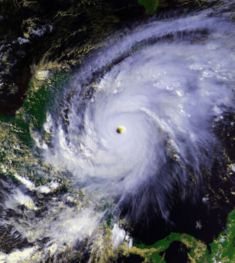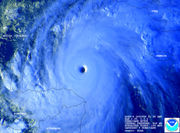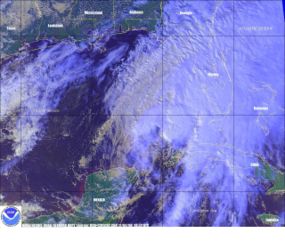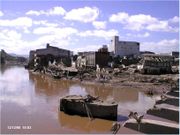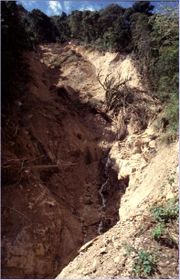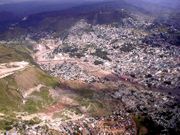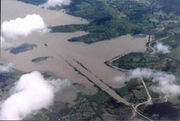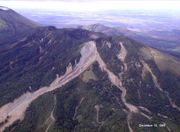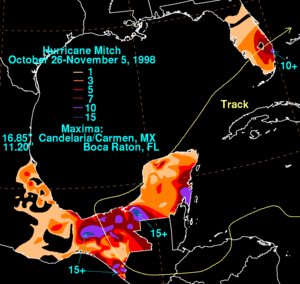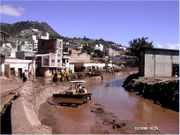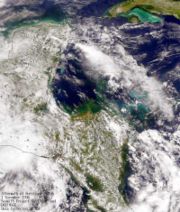Hurricane Mitch
2008/9 Schools Wikipedia Selection. Related subjects: Storms
| Category 5 hurricane ( SSHS) | ||
|---|---|---|
|
Hurricane Mitch at peak intensity |
||
| Formed | October 22, 1998 | |
| Dissipated | November 5, 1998 | |
| Highest winds |
|
|
| Lowest pressure | 905 mbar ( hPa; 26.74 inHg) | |
| Fatalities | 11,000–18,000 direct | |
| Damage | $6.2 billion (1998 USD) $8 billion (2008 USD) |
|
| Areas affected |
Central America (particularly Honduras and Nicaragua), Yucatán Peninsula, South Florida | |
| Part of the 1998 Atlantic hurricane season |
||
Hurricane Mitch was one of the deadliest and most powerful hurricanes on record in the Atlantic basin, with maximum sustained winds of 180 mph (290 km/h). The storm was the thirteenth tropical storm, ninth hurricane, and third major hurricane of the 1998 Atlantic hurricane season. At the time, Hurricane Mitch was the strongest Atlantic hurricane ever observed in the month of October, though it has since been surpassed by Hurricane Wilma of the 2005 season. The hurricane also tied for the fourth most intense Atlantic hurricane in recorded history, but it has since dropped to seventh.
Mitch formed in the western Caribbean Sea on October 22, and after drifting through extremely favorable conditions, it rapidly strengthened to peak at Category 5 status, the highest possible rating on the Saffir-Simpson Hurricane Scale. After drifting southwestward and weakening, the hurricane hit Honduras as a minimal hurricane. It drifted through Central America, reformed in the Bay of Campeche, and ultimately struck Florida as a strong tropical storm.
Due to its slow motion from October 29 to November 3, Hurricane Mitch dropped historic amounts of rainfall in Honduras and Nicaragua, with unofficial reports of up to 75 inches (1900 mm). Deaths due to catastrophic flooding made it the second deadliest Atlantic hurricane in history; nearly 11,000 people were killed with over 8,000 left missing by the end of 1998. The flooding caused extreme damage, estimated at over $5 billion (1998 USD, $6 billion 2006 USD).
Storm history
The origin of Hurricane Mitch can be traced to a tropical wave that moved off the coast of Africa on October 10. It moved westward across the shear-ridden Atlantic Ocean, and remained disorganized until entering the Caribbean Sea on October 18. Upon entering the western Caribbean Sea, convection steadily increased, and on October 22, the wave organized into Tropical Depression Thirteen while 415 miles (670 km) south of Kingston, Jamaica. Under weak steering currents, it drifted westward and intensified into a tropical storm on October 23 while 260 miles (420 km) east-southeast of San Andrés Island.
Initially, intensification was limited due to an upper-level low causing vertical wind shear over Tropical Storm Mitch. As the storm executed a small loop to the north, the shear weakened, allowing the system to strengthen. Mitch attained hurricane status on October 24 while 295 miles (475 km) south of Jamaica, and with warm water temperatures and well-defined outflow, the hurricane rapidly strengthened. During a 24-hour period from October 24 to the 25th, the central pressure dropped 52 mbar, and on October 26, Mitch reached peak intensity with 180 mph (290 km/h) winds and a pressure of 905 mbar, one of the lowest pressures ever recorded in an Atlantic hurricane.
| Rank | Hurricane | Season | Min. pressure |
|---|---|---|---|
| 1 | Wilma | 2005 | 882 mbar ( hPa) |
| 2 | Gilbert | 1988 | 888 mbar (hPa) |
| 3 | "Labor Day" | 1935 | 892 mbar (hPa) |
| 4 | Rita | 2005 | 895 mbar (hPa) |
| 5 | Allen | 1980 | 899 mbar (hPa) |
| 6 | Katrina | 2005 | 902 mbar (hPa) |
| 7 | Camille | 1969 | 905 mbar (hPa) |
| Mitch | 1998 | 905 mbar (hPa) | |
| Dean | 2007 | 905 mbar (hPa) | |
| 10 | Ivan | 2004 | 910 mbar (hPa) |
| Source: U.S. Department of Commerce | |||
A ridge of high pressure forced the hurricane westward, resulting in land interaction with Honduras. This weakened Mitch slightly, and after passing over the Swan Islands on October 27, the hurricane steadily weakened. The ridge of high pressure built further, forcing the hurricane to drift southward along the Honduran coastline. Mitch made landfall 80 miles (130 km) east of La Ceiba in Honduras on October 29 as a Category 1 hurricane on the Saffir-Simpson hurricane scale with 80 mph (130 km/h) winds. It continued to weaken over land, drifting westward through Central America, and its low-level circulation dissipated on November 1 near the Guatemala-Mexico border.
The remnant area of low pressure drifted northward into the Bay of Campeche, and reorganized on November 3 into a tropical storm while 150 miles (240 km) southwest of Mérida, Yucatán. Mitch moved to the northeast, making landfall on the Yucatán Peninsula near Campeche on November 4. It weakened to a tropical depression over land, but restrengthened to a tropical storm over the southeastern Gulf of Mexico. As Mitch accelerated to the northeast in association with a cold front, it gradually intensified, and made landfall near Naples, Florida on November 5 as a tropical storm with 65 mph (100 km/h) winds. Mitch became extratropical later that day, but it continued to persist for several days before losing its identity north of Great Britain on November 9.
Preparations
While stalling over the western Caribbean Sea, Mitch's future was very uncertain, with the National Hurricane Centre advising citizens throughout the area to closely monitor the hurricane. Just 2 days before landfall, there remained a possibility for the hurricane to spare Honduras and hit Guatemala or Belize. Because of the uncertainty, government officials issued hurricane warnings from the Honduras/Nicaragua border to Belize from 2–3 days before landfall.
Due to the threat, the government of Honduras evacuated some of the 45,000 citizens on the Bay Islands and prepared all air and naval resources. The government of Belize issued a red alert and asked for citizens on offshore islands to leave for the mainland. Because the hurricane threatened to strike near Belize City as a Category 4 hurricane, much of the city was evacuated in fear of a repeat of Hurricane Hattie 37 years earlier. Guatemala issued a red alert as well, recommending boats to stay in port, telling people to prepare or seek shelter, and warning of potential overflown rivers. By the time Mitch made landfall, numerous people were evacuated along the western Caribbean coastline, including 100,000 in Honduras, 10,000 in Guatemala, and 20,000 in the Mexican state of Quintana Roo.
Impact
| Region | Direct deaths | Damage |
|---|---|---|
| Panama | 3 | Unknown |
| Costa Rica | 7 | $92 million |
| Jamaica | 3 | Unknown |
| Nicaragua | 3,800 | $1 billion |
| Honduras | 7,000 | $3.8 billion |
| Guatemala | 268 | $748 million |
| El Salvador | 240 | $400 million |
| Belize | 11 | Unknown |
| Mexico | 9 | Unknown |
| United States | 2 | $40 million |
| Offshore | 31 | N/A |
| Total | ~11,000 | $6 billion |
Hurricane Mitch was the deadliest Atlantic hurricane since the Great Hurricane of 1780, displacing the Galveston Hurricane of 1900 as the second-deadliest on record. Nearly eleven thousand people were confirmed dead, and almost as many reported missing. Deaths were mostly from flooding and mudslides in Central America, where the slow-moving hurricane and then tropical storm dropped nearly 3 feet (900 mm) of rain. The flooding and mudslides damaged or destroyed tens of thousands of homes, with total damage amounting to over $5 billion (1998 USD, $6 billion 2006 USD), most of which was in Honduras and Nicaragua. Prior to Mitch, the deadliest hurricane in Central America was Hurricane Fifi in 1974, which killed an estimated 8,000–10,000.
Honduras
Prior to hitting Honduras, Hurricane Mitch sent waves of up to 22 feet (6.7 m) in height to the coast. Upon making landfall, it diminished in intensity, but still caused a strong storm surge and waves of 12 feet (3.7 m) in height. While the storm was drifting over the country, it dropped extreme rainfall peaking at nearly 36 inches (91 cm) in Choluteca, where over 18 inches (46 cm) of rain fell in one day. The rainfall in Choluteca was equivalent to the average rainfall total in 212 days. The Choluteca River at this point flooded to six times its normal width. The widespread flooding was partially caused by Honduras' slash and burn agriculture, so the forests could not absorb any moisture. In addition, there were estimates of as high as 75 inches (190 cm) in mountainous regions. The rainfall collected in rivers, causing extensive river flooding across the country. The deepest average depth was 12.5 meters on the Ulúa River near Chinda, while the average widest length was 359 meters on the Río Lean near Arizona. The rainfall also caused widespread mudslides across the mountainous country.
Mitch caused such massive and widespread damage that Honduran President Carlos Roberto Flores claimed it destroyed fifty years of progress in the country. An estimated 70–80% of the transportation infrastructure of the entire country was wiped out, including nearly all bridges and secondary roads; the damage was so great that existing maps were rendered obsolete. About 25 small villages were reported to have been entirely destroyed by the landslides caused by the storm. Damages to the transportation and communication network totaled to $529 million (1998 USD, $619 million 2006 USD). Across the country, the storm destroyed 33,000 houses and damaged 50,000 others. In addition, it downed numerous trees, leaving mountainsides bare and more vulnerable to mudslides.
Mitch's rainfall resulted in severe crop losses in the country, affecting more than 300 square miles (800 km²) or 29% of the country's arable land. The NCDC estimated the flooding destroyed at least 70% of the country's crops. Food crops were severely impacted, including destruction of 58% of the corn output, 24% of sorghum, 14% of rice, and 6% of the bean crop. Several important export crops faced similar losses, including 85% of banana, 60% of sugar cane, 29% of melons, 28% of African palms, and 18% of coffee. Crop damage alone was estimated anywhere from $900 million (1998 USD, $1 billion 2006 USD) to $1.7 billion (1998 USD, $2 billion 2006 USD). Large amounts of animal losses occurred as well, including the death of 50,000 cattle and the loss of 60% of the poultry population. Shrimp production, which had become an important export, faced nearly complete destruction. Total animal losses amounted to $300 million (1998 USD, $351 million 2006 USD).
The extreme flooding and mudslides killed over 6,500, with several thousand missing. Many of the unidentified were buried in mass graves, resulting in great uncertainty over the final death toll. Over 20% of the country's population, possibly as many as 1.5 million people, were left homeless. The severe crop shortages left many villages on the brink of starvation, while lack of sanitation led to outbreaks of malaria, dengue fever, and cholera.
On the offshore island of Guanaja, the hurricane spent three days stalling near the island. Strong winds destroyed one third of the island's houses and left most citizens without power for months. The island's two fish packing plants were damaged while two main resorts were closed. Guanaja received little help from the national government, being a small (9 miles long, 14 km) island which has traditionally had an independent and self-reliant streak. Instead, international aid arrived from former Guanaja citizens, enough that citizens from the mainland came to the island to acquire supplies.
Nicaragua
Though Mitch never entered Nicaragua, its large circulation caused extensive rainfall, with estimates of over 50 inches (127 cm). In some places, as much as 25 inches (64 cm) of rain fell on coastal areas. The flank of the Casita Volcano failed and turned into a lahar from excessive rain. The resulting mudslide ultimately covered an area 10 miles (16 km) long and 5 miles (8 km) wide.
Two million people in Nicaragua were directly affected by the hurricane. Across the country, Mitch's heavy rains damaged 17,600 houses and destroyed 23,900, displacing 368,300 of the population. 340 schools and 90 health centers were severely damaged or destroyed. Sewage systems and the electricity subsector were severely damaged, and, combined with property, damage totaled to $300 million (1998 USD, $351 million 2006 USD).
Transportation was greatly affected by the hurricane, as well. The rainfall left 70% of the roads unusable and destroyed or greatly damaged 71 bridges. Over 1,700 miles (2700 km) of highways or access roads needed replacement subsequent to the storm, especially in the northern part of the country and along portions of the Pan-American Highway. Total transportation damage amounted to $300 million (1998 USD, $351 million 2006 USD). Agricultural losses were significant, including the deaths of 50,000 animals, mostly bovines. Crops and fisheries were affected greatly as well, and, combined with agricultural losses, damage totaled to $185 million (1998 USD, $217 million 2006 USD).
The situation was further compounded by a total of 75,000 live land mines — left over from the Contra insurgency of the 1980s — that were calculated to have been uprooted and relocated by the floodwaters.
In all, Hurricane Mitch caused at least 3,800 fatalities in Nicaragua, of which more than 2,000 were killed in the towns of El Provenir and Rolando Rodriguez from the landslide at the Casitas volcano. The mudslide buried at least four villages completely in several feet of mud. Throughout the entire country, the hurricane left between 500,000 and 800,000 homeless. In all, damage in Nicaragua is estimated at around $1 billion (1998 USD, $1.17 billion 2006 USD).
Caribbean Sea
Mitch was also responsible for the loss of the Fantome windjammer sailing ship owned by Windjammer Barefoot Cruises; all 31 of the crew perished. The story was recorded in the book The Ship and The Storm by Jim Carrier. The ship, which was sailing in the centre of the hurricane, experienced up to 50 foot (15 m) waves and over 100 mph (160 km/h) winds, causing the Fantome to sink off the coast of Honduras.
On the south coast of Cuba, the hurricane caused waves of up to 13 feet (4 m) high and winds gusts peaking at 42 mph (67 km/h), causing numerous tourists and workers on the Isle of Youth and Cayo Largo del Sur to leave for safer grounds.
In Jamaica, where officials declared hurricane warnings 12 hours prior to its closest approach, Mitch caused moderate rainfall and gusty winds for days. Strong waves hit western Jamaica, with wave heights unofficially estimated at nearly 7 feet (2 m) in height. The rainfall in outer rainbands, at times severe, flooded many roads across the island and left them covered with debris. One house in Spanish Town collapsed from the flooding, leaving four homeless. Many other homes and buildings were flooded, forcing many to evacuate. A river in northeastern Jamaica overflowed its banks, while heavy rainfall across the mountainous parts of the country caused numerous mudslides. In all, Mitch killed three people on Jamaica.
On the Cayman Islands, the hurricane caused strong waves, gusty winds, and heavy rainfall at times. Damage was relatively minimal, amounting to blown out windows and beach erosion. Strong waves damaged or destroyed many docks on the south shore of the islands, and also sank one dive ship near Grand Cayman. In addition, numerous incoming and outgoing flights were cancelled.
Rest of Latin and Central America
| Rank | Hurricane | Season | Fatalities |
|---|---|---|---|
| 1 | "Great Hurricane" | 1780 | 22,000 |
| 2 | Mitch | 1998 | 11,000 – 18,000 |
| 3 | "Galveston" | 1900 | 8,000 – 12,000 |
| 4 | Fifi | 1974 | 8,000 – 10,000 |
| 5 | "Dominican Republic" | 1930 | 2,000 – 8,000 |
| 6 | Flora | 1963 | 7,186 – 8,000 |
| 7 | "Pointe-à-Pitre" | 1776 | 6,000+ |
| 8 | "Newfoundland" | 1775 | 4,000 – 4,163 |
| 9 | "Okeechobee" | 1928 | 4,075+ |
| 10 | "San Ciriaco" | 1899 | 3,433+ |
| See also: List of deadliest Atlantic hurricanes | |||
Due to Mitch's large circulation, it dropped heavy precipitation as far south as Panama, especially in the Darién and Chiriquí provinces. The flooding washed away a few roads and bridges, and damaged numerous houses and schools, leaving thousands homeless. The hurricane left three casualties in Panama.
In Costa Rica, Mitch dropped heavy rains, causing flash flooding and mudslides across the country, mostly in the northeastern part of the country. The storm impacted 2,135 homes to some degree, of which 242 were destroyed, leaving 4,000 homeless. Throughout the country, the rainfall and mudslides affected 126 bridges and 800 miles (1300 km) or roads, mostly on the Inter-American Highway which was affected by Hurricane Cesar, two years prior. Mitch affected 115 sq. miles (300 km²) of crop lands, causing damage to both export and domestic crops. In all, Hurricane Mitch caused $92 million in damage (1998 USD, $108 million 2006 USD) and seven deaths.
While drifting through El Salvador, the hurricane dropped immense amounts of precipitation, resulting in flash flooding and mudslides through the country. Multiple rivers, including the Río Grande de San Miguel and the Lempa River overflowed, contributing to overall damage. The flooding damaged more than 10,000 houses, leaving around 59,000 homeless and forcing 500,000 to evacuate. Crop damage was severe, with serious flooding occurring on 386 sq. miles (1000 km²) of pasture or crop land. The flooding destroyed 37% of the bean production, 19% of the corn production, and 20% losses in sugar canes. There were heavy losses in livestock as well, including the deaths of 10,000 cattle. Total agricultural and livestock damaged amounted to $154 million (1998 USD, $180 million 2006 USD). In addition, the flooding destroyed two bridges and damaged 1,200 miles (2000 km) of unpaved roads. In all, Mitch caused nearly $400 million in damage (1998 USD, $468 million 2006 USD) and 240 deaths.
Similar to the rest of Central America, Mitch's heavy rains caused mudslides and severe flooding over Guatemala. The flooding destroyed 6,000 houses and damaged 20,000 others, displacing over 730,000 and forcing over 100,000 to evacuate. In addition, the flooding destroyed 27 schools and damaged 286 others, 175 severely. Flooding caused major damage to crops, while landslides destroyed crop land across the country. The most severely affected crops for domestic consumption were tomatoes, bananas, corn, other vegetables, and beans, with damaged totaling to $48 million (1998 USD, $56 million 2006 USD). Export crops such as bananas or coffee were greatly damaged as well, with damage amounting to $325 million (1998 USD, $380 million 2006 USD). Damage to plantations and soil totaled to $121 million (1998 USD, $142 million 2006 USD). The flooding also caused severe damage to the transportation infrastructure, including the loss of 37 bridges. Across the country, flooding damaged or destroyed 840 miles (1350 km) of roads, of which nearly 400 miles (640 km) were sections of major highways. In all, Hurricane Mitch caused $748 million (1998 USD, $876 million 2005 USD) and 268 deaths in Guatemala. In addition, Mitch caused 11 indirect deaths when a plane crashed during the storm.
In Belize, the hurricane was less severe than initially predicted, though Mitch still caused heavy rainfall across the country. Numerous rivers exceeded their crests, though the rainfall was beneficial to trees in mountainous areas. The flooding caused extensive crop damage and destroyed many roads. Throughout the country, eleven people died because of the hurricane.
In Mexico, Mitch produced gusty winds and heavy rains on the Yucatán Peninsula, with Cancún on the Quintana Roo coast being the worst hit. Nine people were killed from the flooding, though damage was relatively minimal. The maximum 24 hour rainfall total from Mitch was 13.4 inches (340 mm) in Campeche, while the highest rainfall total was 16.85 inches (428 mm) in Ciudad del Carmen.
Florida
Then a tropical storm, Mitch caused a storm surge of up to four feet in the lower Florida Keys before making landfall on the Florida west coast. Key West International Airport reported peak wind gusts of 55 mph (89 km/h) and sustained winds of 40 mph (64 km/h), the only report of tropical storm force in the state. In addition, Mitch caused moderate rainfall, peaking at seven inches (18 cm) in Jupiter, though some estimates indicate localized totals of up to 10 inches (25 cm). The storm spawned five tornadoes over the state, of which the strongest was an F2.
In the Florida Keys, multiple buildings that had been damaged by Hurricane Georges were leveled by Mitch. Tornadoes from the storm damaged or destroyed 645 houses across the state, as well as injuring 65 people. Gusty winds left 100,000 without power during the storm's passage. In all, Mitch caused $40 million in damage (1998 USD, $47 million 2006 USD) in Florida and two deaths from drowning when two boats capsized.
Aftermath
Because of the hurricane's destruction in Central America and elsewhere in North America, the World Meteorological Organization retired the name Mitch in the spring of 1999; it will never again be used for an Atlantic hurricane. The name was replaced with Matthew in the 2004 season.
After the disaster caused by Hurricane Mitch, countries around the world donated significant aid, totaling $6.3 billion (1998 USD, $7.4 billion 2006 USD). Throughout Central America, which was recovering from an economic crisis that occurred in 1996, many wished to continue the growth of the infrastructure and economy. In addition, after witnessing the vulnerability to hurricanes, the affected governments endeavored to prevent such a disaster from occurring again.
Hundreds of thousands of people lost their homes, but many took this as an opportunity to rebuild stronger houses. With a new, structurally improved foundation, homes were redesigned to be able to withstand another hurricane. However, lack of arable crop land took away the jobs from many, decreasing an already low income even lower.
Following the passage of Mitch, disease outbreaks occurred throughout Central America, including cholera, leptospirosis, and dengue fever. Over 2,328 cases of cholera were reported, killing 34 people. Guatemala was most affected by the virus, where most of the deaths occurred from contaminated food. 450 cases of leptospirosis were reported in Nicaragua, killing seven people. There were over 1,357 cases of dengue reported, though no deaths were reported from the disease.
While stalling over the western Caribbean Sea, Mitch's strong winds produced strong waves, damaging local coral reefs. Later, the storm's immense rainfall led to runoff polluted with debris and fresh water. This resulted in diseases occurring within the coral. However, the hurricane's upwelling cooled the warm water temperatures, preventing significant bleaching and destruction of the coral reef.
Honduras, the country most affected by the hurricane, received significant aid for the millions impacted by the hurricane. Mexico quickly gave help, sending 700 tons of food, 11 tons of medicine, four rescue planes, rescue personnel, and trained search dogs. Cuba also volunteered, sending a contingent of physicians to the country. The U.S. administration offered at first troops stationed in Honduras, and then withdrew them a few days after the storm. They also at first offered only $2 million (1998 USD, $2.3 million 2006 USD) in aid, which came as a shock to residents, and president Carlos Roberto Flores alike. The U.S. later increased their offer to $70 million (1998 USD, $82 million 2006 USD). The Honduran government distributed food, water, and medical services to the hurricane victims, including the more than 4 million without water. President Flores turned the administration of the relief efforts to the church, both Protestant and Catholic. The relief effort was carried out with virtually no incidents; only one truck was discovered to be re-routed for personal use, and the person responsible for this was subsequently punished. In addition, the country initially experienced a sharp increase in the unemployment rate, largely due to the destruction of crop lands. However, rebuilding provided jobs in the following years. In Costa Rica, reconstruction after the hurricane increased the number of jobs by 5.9%, lowering the unemployment rate slightly.
